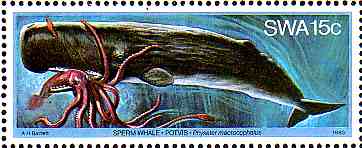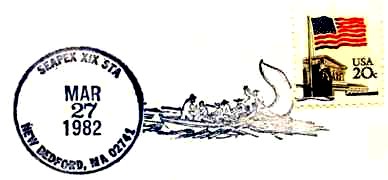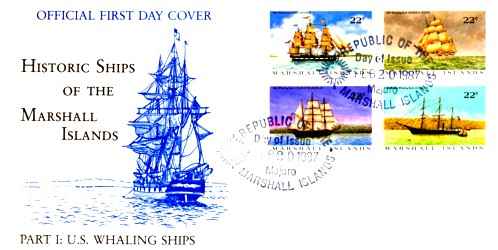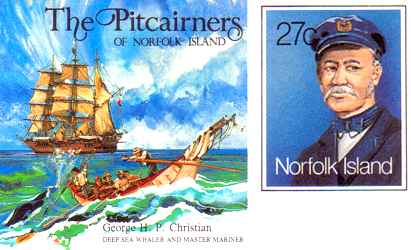|

| |
Sperm whales are tooth whales, i.e. there are no whale-bones. Males are up to 60 ft long, females up to around 40 ft; their weight
is between 35 to 60 tons. With a box-shaped head and one nose blow hole, they dive some 10,000 ft deep to catch
food such as squids and huge octopuses (see stamp). An oxygen-binding protein in their muscle tissue enables them
to remain under water for one to two hours. In addition to their blubber, sperm whales were highly prized for the oil
in their heads, the spermaceti, and the ambergris, a waxlike secretion of the intestine, both used in the manufacture
of perfumes.
| |
|
Most American whalers hailed from Nantucket and New Bedford. 1752 the first sperm whale was caught in
New England waters. In 1774 these two ports alone accounted for a fleet of 560 whalers with approximately
9,000 men. By 1846, there were 755 barks, brigs and ships that sailed from New England with some 20,000 men.
Sperm whales were the main catch but smooth whales were hunted as well.
|

|

|
A whaling voyage lasted two to four years and often led the whalers around the world. From New England they
sailed south around Cape Horn and then into the hunting grounds in the Pacific. Once the barrels were filled with
whale oil, they went homeward-bound the way they came or they sailed across the Indian Ocean and around the
Cape of Good Hope.
| |

| |
The "Charles W. Morgan" was a typical New Bedford whaler.
Built 1841, L x B x D = 111 x 29 x 13 feet, 313 tons, three masts, wooden
hull with a black-and-white ‘gunport’ stripe, four whale-catching boats, rigged some times as a bark and others
as a ship, with a crew of 33 men. Between 1841 to 1920 the ship performed 37 whaling voyages.
Beached in 1925, the vessel was refloated and restored in 1941. With ongoing restoration, serving as a much
revered museum ship at Mystic Seaport, Connecticut.
| |

|
When the lookout discovered a whale’s streaming blow, the ship heaved to and the boats were lowered.
Each boat contained 6 men, oarsmen, mate and harpooner. Once close enough to the whale, the harpoon was
thrown into its side behind the head. The whale would take off and the rope rushed out. If the whale dived,
a second or third rope, each 200 fathom long (approx. 1,196 ft) was attached.
The post the rope was looped around was cooled with water to protect against burns from the friction’s heat .
| |
|
All the boats nearby would throw additional harpoons. Trying to escape, the whale often dragged several boats
behind it for hours. Once the animal was exhausted, it was killed with a lance the mate thrust at the whale’s heart
or lung area. The sharp lance point was repeatedly stuck into the whale until it bled to death. If other whales
were still nearby, the dead animal was marked with a red flag and the hunt continued.
|

| |

|

|
Sperm whales weighing 60 tons were powerful adversaries who resisted capture using their mighty jaws and strong flukes.
To protect themselves and the herd, they attacked boats and even large vessels. For the men in the boats it was a fight
for life and death every time . Quite often, boats were smashed by the tail fin or the whale swam underneath the boat
and capsized it.
Was the captured whale drifting on the ship’s leeward side, the ship was sailed towards the catch, otherwise
the whale was dragged alongside by the boats.
| |
|
There was an extraordinary sperm whale the whalers named 'Mocha Dick', after the location
off Chile’s Mocha Islands where its first attacks on whaling vessels were recorded. It had a gray skin and a 2.5 meters
long white scar across its head. Between 1810 and 1859 this whale destroyed dozens of boats and even attacked
large whaling ships. Other famous whales were 'Timor Jack' and 'New Zealand Tom. They actually sank the
whalers 'Essex' (1820), 'Pusie Hall' (1835), 'Two Generals' (1838), 'Pocahontas' (1850) and 'Ann Alexander' (1851).
|

| |

|
The captured whale was lashed to the ship’s side with chains through the head and around the tail fin. Next, the lower
jaw was separated and heaved on deck, then the head was cut off. Dissecting the head was left for last, to prevent
the blubber from becoming a feast for the sharks. From a stage outside the hull the skin was slit with long knives,
the blubber was raised by block and tackle, and in a spiraling motion the fat was separated from the body.
| |
To obtain the spermaceti a hole was cut into the head and the oil was scooped out with a bucket.
| |
Once all the blubber was torn off the whale, the large kettles were fired with wood and the fat was boiled.
The nonmelting skin was used as additional fuel. The harvested oil went into cooling containers and then into barrels
holding 31.5 gallons (117.4 litres). A sperm whale cow yielded 35 barrels, a large bull 75 to 90 barrels.
The spermaceti of big animals amounted to 25 to 30 barrels.
On the stamp we see the brick-built kettle and besides it the round cooling container.
The extracted oil swam on the surface, while impurities and dirty particles sank to to the ground.
|

| |

| |
Once the the blubber was taken off, the remains were left to the sharks.
In their log books the whalers reported encounters with the animals with distinctive marks (stamp left).
Different marks represented sighted whales, success (entire whales) and failure (dived-away whales).
The stamp on the right shows two harpoons with their barbs.
| |

|

| |
Applied uses of whale products: The oil was needed for lamps and soap; the special spermaceti oil for candles;
whale bones for corsets, umbrellas, supports, walking sticks, etc.; meat and bone meal as fertilizer for agriculture
and animal feed. The oil was also used by industry, for heating and as a lubricant for sewing machines, among others.
Also, streetlamps and lighthouses were fueled with sperm whale oil. The ambergris was prized for perfume production.
Whale meat was consumed by aboriginal cultures and the Japanese, the tongue being a special delicacy.
| |

|
In 1851 "Benjamin Tucker" returned with 2,340 barrels whale oil, 170
barrels spermaceti and 30,012 pounds whale bone. Earnings amounted to 47,682.73 dollars.
"Sarah" of Nantucket once obtained 89,000 dollars for 3,487 barrels.
During her 80-year whaling career the owners of "Charles W. Morgan" achieved a profit in excess one million dollars.
Whaling was indeed a very lucrative business for shipowners
| |
|
A whaler’s crew consisted of a master, a first and second mate, a
bosun, harpooner, coopers, cook, sailors and ship’s boys.
They received no set wages but a percentage of the net profits (after a 60-70% deduction for the shipowner).
The master got 1/10, first mate 1/15, harpooner 1/90, sailors 1/150,
ship’s boys 1/300. The end of a good voyage could amount to between 1500 to 50 dollars per crew member.
Food and accommodations were free, but consumer products and tobacco bought from the captain’s slop chest
had to be accounted for.
|

| |
That often led to the fact that a sailor had no money left after a three-year journey and had no other choice than to sign on again for the next voyage, whether he wanted to or not.
The food supply consisted of salted meat, hard tack and canned vegetables.
Fresh water and fresh vegetables were obtained at ports of call and islands. Many whalers provisioned themselves in the Galapagos Islands with giant tortoises. They were stored alive upside down in the hold until it was time for slaughter.
The postal stationery depicts Captain George H.P. Christian who at one time had command of the "Charles W. Morgan".
| |

|
The voyages were long and also boring when no whales were sighted for weeks.
The crew often passed the time creating scrimshaw, engravings on whale teeth and bones which were then dyed black,
and carving a wide variety of objects such as handles for walking sticks, whistles, candleholders, lanterns,
boxes, egg cups, corset sticks, laundry clips, rings, birdcages, pie cutting wheels, ship models etc. etc.
Scrimshaw designs show mostly scenes of whale-hunting, ships, and women.
| |
|
Decrease in the whale populations, 1850’s gold fever in California, the 1859 discovery of oil, and the depredations
of Confederate raiders during the Civil War led to the demise of the American whaling industry by the end of the
19th Century. The introduction of petroleum led to a drastic fall of whale oil prices which dropped from
1.77 dollars/gallon in 1855 to only 40 cents by 1896. At this level, whaling was no longer worth the effort.
The stamp at right shows two harpoon guns. They represent the beginning of
a development which led to the massive slaughter of whales.
"Maritime Topics on Stamps" will report on it in ‘Whaling, Part 3'.
|

| |
|